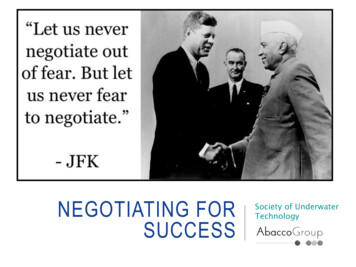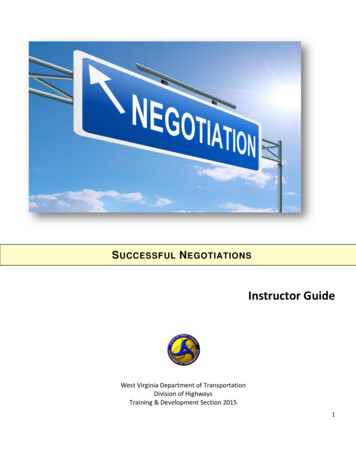
Transcription
NEGOTIATING FORSUCCESSSociety of UnderwaterTechnology
NEGOTIATING FOR SUCCESS Introduction 3 Simple Steps to Reaching a SuccessfulNegotiation Find Your Negotiation Style Lets Practice Review
3 STEPS FOR NEGOTIATIONStep 1: Prepare – 60%-Plan your strategy-Find your source of powerStep 2: Negotiate-Use your source of power, Use your BATNA.Step 3: review-Learn
STEP 1: PREPAREPLAN YOUR STRATEGY1. Should I negotiate?In making a decision about whether to negotiate, consideryour feelings about negotiating as well as the potential risksand rewards.2. Position or interest based negotiation?Position is about WHAT do you/other party wants, Interest isabout WHY do you/other party wants.Regardless if a negotiation appears to be position or interest:Always look for underlying interests, and be ready for apositional bargaining.
STEP 1: PREPAREPLAN YOUR STRATEGY3. Is it a dispute or making a deal?DEALDISPUTEForward Looking, InterestedBased, Problem SolvingBackward Looking, PositionBase, AdversarialPerspective: Complete yourfact finding to find pathwaysPower: Force the outcome youwantExplore: Your BATNA optionsand possibilitiesRights: A third party decideBring: Arbitrator/mediator fordeal makingAvoid: Do nothing and let theother party have what theywant
STEP 1: PREPAREPLAN YOUR STRATEGY4. Should I use a 3rd party to negotiate for me?You can always use a mediator, arbitrator or judge5. What is your source of power?Best Alternative to a Negotiated Agreement (BATNA) –yoursource of Leverage & POWERAHow powerful arethey?Their BATNABHow can you Improve yourpower?Your BATNACHow can you weaken theirpower?Their BATNA
BATNA HOW TO FIND & USE*Your Best Alternative to a Negotiated Agreement (BATNA) is your source of power during anegotiation. Your BATNA gives you leverage to walk away if the other side doesn’t give you a betterdeal than your best alternative. To develop your power, answer the following questions:1. What is my BATNA? (This should be the first question that you ask yourself when preparing fornegotiations. If your BATNA is better than what the other side can offer, walk away from thenegotiation.)2. Should I disclose my BATNA to the other side during negotiations? (As a general rule, you willwant to disclose a strong BATNA because that signals your strength and you will want to hide aweak BATNA.)3. If I have a weak BATNA, should I lie about my alternatives? (Lying is never recommended and inthis situation it is especially dangerous because courts have held that lying about BATNAs can beconsidered fraud).4. Do I know what the other side’s BATNA is? How can I find their BATNA? (This is the way that youwill determine the strength of the other side. Decide what questions to ask during the negotiationto find the other side’s BATNA.)5. How can I weaken the other side’s BATNA? (In other words, how can you weaken the other side’spower? Before the negotiation, try to predict their BATNA and think about how you can weaken it.)6. How can I strengthen my BATNA? (In other words, how can you strengthen your power during thenegotiation?)
STEP 1: PREPAREPLAN YOUR STRATEGY6. Is this a x cultural or x generation negotiation?Where to start? Gap analysis the major difference between their negotiation style and yours.Analysing the other’ssides interestAnalysing your interestX CulturalNegotiation style &surface cultureValues and beliefs& deep cultureWhat to do?Should you adopt the negotiation style of the other side?. NOPE.But try to identify key features.Traditions are different greetings, body language, etc. Do you HomeworkBE SENSITIVE TO DIFFERENCE IN CULTURE AND AGE BUT DON’T STEREOTYPE
WHAT IS YOUR NEGOTIATIONSTYLE?To assess your negotiation style while preparing fornegotiations, complete the following three steps:1. Complete the assessment and understand your negotiatingstyle.2. Use the assessment to assess the style of the other side.3. Do a gap analysis. Locate the major gaps between your styleand the style of the other side. Focus on these gaps whenpreparing for the negotiation.*Thank you to Jeswald Salacuse, Henry J. Braker Professor of Law and former Dean of The Fletcher School at Tufts University. For furtherinformation, see Chapter 2, “Determine the Type of Negotiation”*Ref, Negotiating for Success, Chapter 5, “Develop Your Relationships and Your Power”
WHAT IS YOUR NEGOTIATIONSTYLE?Negotiation /LosePersonal StyleInformalCommunicationsDirectTime t FormSpecificAgreement BuildingBottom UpTop DownTeam EnvironmentOne LeaderConsensusRisk TakingHighWin/WinFormalIndirectGeneralLow
WHAT IS YOUR NEGOTIATIONSTYLE?
STEP 2: NEGOTIATENegotiation StrategiesBATNA: Find the A, B, C, by using the how to find and usequestions.Big Picture: Look at the interests and why.Relationship Building: ongoing relationshipsSuccessful NegotiationAsk questions Your power is inthe information, Listen to theanswers.Get to know the other sideUNDERSTANDYOUR POWER ANDTHEIR POWERLISTEN – LISTEN – LISTENASK – ASK - ASK – LISTEN
THE QUESTIONS1.What is your overall goal in reaching an agreement?2.What issues are most important to you in reaching this goal?Why are these issues important?3.What is your Best Alternative to a Negotiated Agreement(BATNA)?4.What is your reservation amount/time?5.What is your most likely amount/time?6.What is your stretch goal? – very important, pick a large onebut with out losing credibility.
ENOUGH QUESTIONS?NOThink about it from the other side What is their answer to yoursame questions. Pick your agreement zone.YOUBATNARESERVATIONMOST LIKELYSTRETCHAgreement ZONESTRETCHMOST LIKELYRESERVATIONBATNAOTHER
3- REVIEWYou can Follow a Becton Dickinson Process (BD)- DAMIDefine: Elaborate a process map showing the steps innegotiationAnalyse:What was done, questions asked, did you useyour BATNA.Measure: Resources and time used to completenegotiationImprove: What could have been done better?
TO REMEMBER 3 STEPS to a Successful Negotiation 60%, 30%, 10%. LISTEN - LISTEN – LISTEN Ask Questions. BE PRESENT BATNA POWER LEVERAGE Look at all negotiations from the other side’sperspective Be sensitive to difference in culture and age butdon’t stereotype Review, learn & improve
LETS KEEP ENGAGEDWWW.ABACCO.COM.AUINFO@ABACCO.COM.AUM- 043 909 8686THANK YOU!
To assess your negotiation style while preparing for negotiations, complete the following three steps: 1. Complete the assessment and understand your negotiating style. 2. Use the assessment to assess the style of the other side. 3. Do a gap analysis. Locate the major gaps between your style and the style of the other side. Focus on these gaps when











